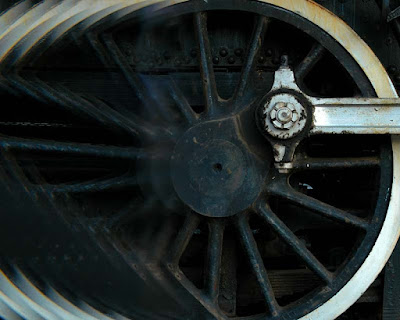 Today's image is an exercise in previsualization. If you have an idea of the end result you're looking for, you can do the work in the camera rather than "creating" the image in Photoshop. That's what's happened with today's shot. The assignment was to present an image that implied motion for the local railroad. Enough negative space had to be left have the article start over the shot. One of the things a photographer has to keep in mind is the intended use of the image you're shooting. If you're on assignment for something to be published or you're shooting for stock photography "space" has to be a consideration. When you have an assignment you know what the end use will be. In most cases you have an Editor or Art Director with a concept of what he/she is looking for and it's up to the photographer to execute. It's sort of like Star Trek, The Next Generation, when the Captain says to his second in command, "make it so, number one". The Captain, Editor or Art Director really doesn't give a rats ... about the "how" of the shot, just that the "mission" accomplishes the objective. One the other hand, if you're shooting for a stock photography house, you don't know what the end use will be. You're shooting "on spec". You're hoping an image is going to sell and, most likely, you'll never see what the use was. Every once in a while you'll open a magazine and see one of your shots in some interesting (or not so interesting) advertisement. A little searching of the internet (check out "This Looks Shopped") can typically come up with the same image being used for totally different campaigns. One of the more "famous" (or infamous) shots that was used to illustrate a point is of O. J. Simpson. Both Newsweek and Time used the exact same "mug shot" image on the cover when O. J. made the headlines back in 1994. Newsweek ran a fairly straight version of the image and Time used a heavily burned in treatment. The editorial difference was very obvious. To find out if today's image is "real" or if it's "Photoshopped", hit the "read more".
Today's image is an exercise in previsualization. If you have an idea of the end result you're looking for, you can do the work in the camera rather than "creating" the image in Photoshop. That's what's happened with today's shot. The assignment was to present an image that implied motion for the local railroad. Enough negative space had to be left have the article start over the shot. One of the things a photographer has to keep in mind is the intended use of the image you're shooting. If you're on assignment for something to be published or you're shooting for stock photography "space" has to be a consideration. When you have an assignment you know what the end use will be. In most cases you have an Editor or Art Director with a concept of what he/she is looking for and it's up to the photographer to execute. It's sort of like Star Trek, The Next Generation, when the Captain says to his second in command, "make it so, number one". The Captain, Editor or Art Director really doesn't give a rats ... about the "how" of the shot, just that the "mission" accomplishes the objective. One the other hand, if you're shooting for a stock photography house, you don't know what the end use will be. You're shooting "on spec". You're hoping an image is going to sell and, most likely, you'll never see what the use was. Every once in a while you'll open a magazine and see one of your shots in some interesting (or not so interesting) advertisement. A little searching of the internet (check out "This Looks Shopped") can typically come up with the same image being used for totally different campaigns. One of the more "famous" (or infamous) shots that was used to illustrate a point is of O. J. Simpson. Both Newsweek and Time used the exact same "mug shot" image on the cover when O. J. made the headlines back in 1994. Newsweek ran a fairly straight version of the image and Time used a heavily burned in treatment. The editorial difference was very obvious. To find out if today's image is "real" or if it's "Photoshopped", hit the "read more".Today's image would probably have been cheaper if it was done in Photoshop. It would have been easy enough to create the repeating pattern of the wheel. Instead, I went out and bought a specialty filter made by Cokin. A Multi-Parallel P209 filter to be exact. The filter goes for almost $50.00 at B&H in NYC, and it's a plastic filter to boot. There were several shots taken, trying different ways to show a train in motion, but that shoot was the only time the filter has been taken out of the case. It sits on a shelf, not even carried to a typical shoot. If, at some point, the proper assignment comes along, I'll be all set. Until then, it was one way to "get the job done". Was it the best ROI (return on investment)? Not yet, but it proved that Photoshop isn't the only way to make a "gimmick" shot.





0 comments:
Post a Comment